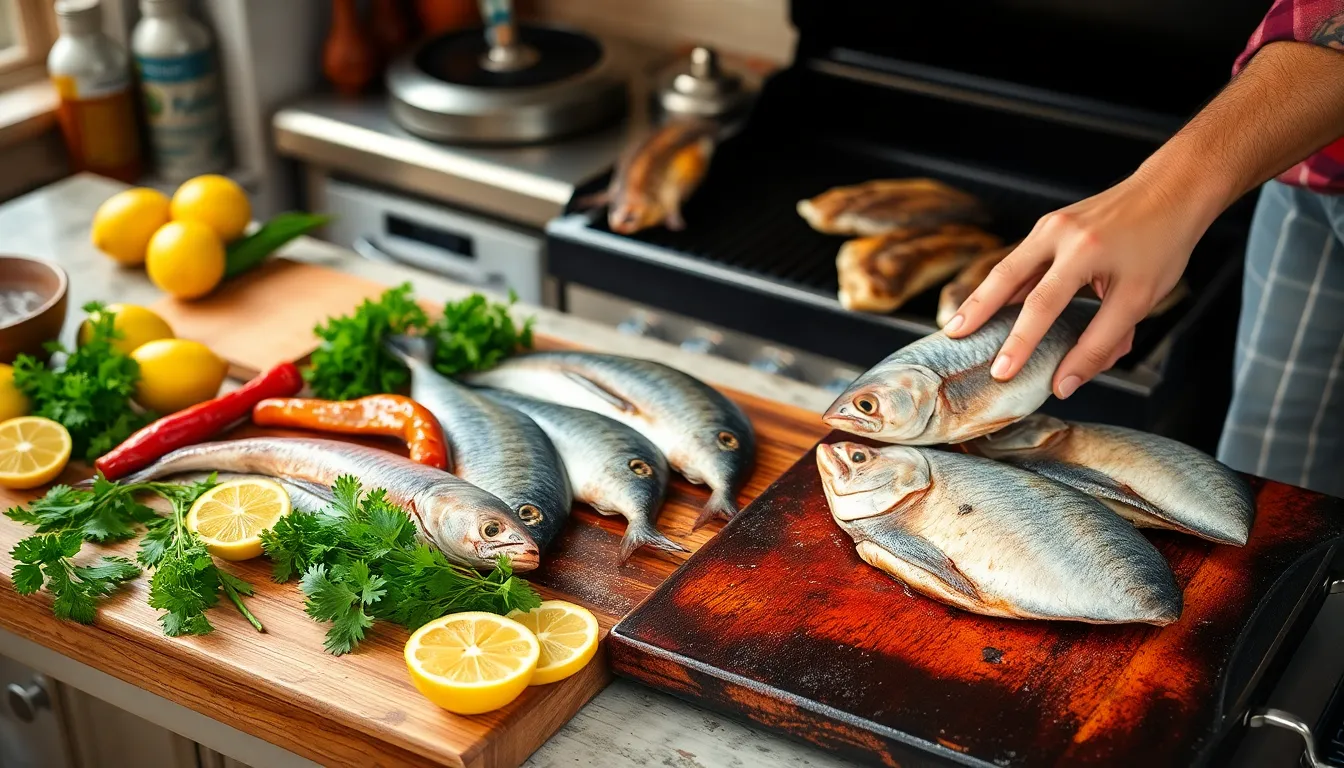When it comes to cooking fish, the options are as vast as the ocean itself. Whether you’re a seasoned chef or a kitchen novice, mastering the art of fish preparation can elevate any meal from mundane to mouthwatering. Imagine biting into a perfectly grilled salmon or savoring a delicate poached trout—it’s enough to make anyone weak in the knees.
Table of Contents
ToggleOverview of Fish Cooking Methods
Diverse cooking methods exist for preparing fish, each offering unique flavors and textures. Grilling enhances natural smokiness while providing a delicious char. Baking allows for ease and simplicity, often paired with herbs and spices for added depth.
Sautéing requires a hot pan and a bit of oil, resulting in a crispy exterior. Poaching gently cooks fish in broth or water, preserving moisture and delicate flavors. Steaming maintains nutrients and texture, often favored in healthy cooking.
Frying creates a crispy coating, popular for fish tacos and sandwiches. Sous vide, a precise technique, involves vacuum-sealing fish and cooking it in a water bath at controlled temperatures for perfect consistency.
Ceviche, a unique method, relies on citrus acidity to ‘cook’ raw fish, resulting in fresh and tangy flavors. The choice of cooking method significantly impacts the dish’s overall taste and presentation.
Experimenting with these techniques can elevate a simple fish dinner to a gourmet experience. Understanding these methods allows cooks to match their approach with the type of fish chosen and the desired outcome.
Popular Fish Cooking Methods

Various cooking methods cater to different tastes and preferences, each creating unique flavors and textures in fish dishes. Exploring these methods can enhance cooking skills, whether for novice or experienced cooks.
Grilling Fish
Grilling offers a smoky flavor that complements various fish types, including salmon and swordfish. Direct heat creates a crispy exterior while retaining moisture within. Using a preheated grill ensures even cooking and prevents sticking. Marinades enhance taste and contribute to caramelization on the surface. It’s advisable to monitor cooking times carefully; thinner fillets often take less time than thicker cuts.
Baking Fish
Baking fish provides a gentle cooking method ideal for flaky varieties such as cod and tilapia. Using parchment paper or foil helps lock in moisture, preventing dryness. Setting the oven temperature between 350°F and 425°F yields consistent results. Moreover, seasoning with herbs and citrus adds aromatic elements to the dish. Fish typically cooks in 10 minutes per inch of thickness, making timing crucial for optimal texture.
Steaming Fish
Steaming maintains the delicate flavors and nutrients in fish, making it a healthy cooking option. Many choose varieties like trout and halibut, which benefit from this gentle method. A steamer basket filled with water creates a moist environment, ensuring even cooking without added fats. Adding aromatics such as ginger or lemon enhances flavor during steaming. Typically, cooking times range from 6 to 10 minutes depending on thickness.
Poaching Fish
Poaching involves cooking fish gently in simmering liquid, often water or broth. This method is well-suited for tender fish like sole or salmon, as it preserves moisture and flavor. The ideal poaching temperature hovers around 160°F to 180°F, preventing the fish from becoming tough. Herbs and spices infuse the liquid, imparting subtle flavor variations. Timing usually requires around 10 minutes per inch of thickness.
Frying Fish
Frying fish generates a crispy texture that many find appealing. This method works well for varieties like haddock and catfish. It’s important to heat oil to approximately 350°F for optimal frying results. Breading or battering the fish enhances texture, creating a satisfying crunch. Cooking times typically range from 3 to 5 minutes per side, depending on thickness. Maintaining oil temperature is vital to achieve a golden-brown finish without excessive greasiness.
Tips for Cooking Fish Perfectly
Cooking fish perfectly requires attention to detail and understanding of key elements. Several tips can help achieve the desired results, ensuring a delicious meal.
Choosing Fresh Fish
Selecting fresh fish enhances flavor and texture. Look for fish with clear eyes, bright red gills, and firm flesh. Fresh seafood should also have a clean, ocean-like smell, not a strong, fishy odor. Purchase fish from reputable sources or local fish markets. Opting for seasonal fish guarantees freshness and sustainability. Not all varieties hold the same quality; for instance, salmon and snapper are often prized for their freshness.
Seasoning and Marinades
Seasoning fish elevates its natural flavors. A simple combination of salt, pepper, and lemon enhances most varieties. Experimenting with herbs, such as dill or parsley, adds depth without overpowering the fish. Marinades can also enhance moisture and flavor during cooking. Acidic ingredients, like citrus juice or vinegar, tenderize the fish while infusing additional taste. Allowing the fish to marinate for 30 minutes to an hour often yields the best results.
Cooking Times and Temperatures
Understanding cooking times and temperatures is crucial for perfectly cooked fish. Fish generally cooks at about 10 minutes per inch of thickness at a temperature of 350°F. Using a food thermometer can ensure doneness; the internal temperature should reach 145°F. Different cooking methods may require adjustments; grilling often results in quicker cooking times compared to baking. Monitoring closely prevents overcooking, which can lead to dryness, thus preserving moisture and flavor.
Exploring various fish cooking methods opens up a world of culinary possibilities. Each technique brings its own unique flavor and texture to the table. Whether grilling for a smoky finish or poaching for delicate tenderness, there’s a method suited for every taste and occasion.
By honing these skills and understanding the nuances of each technique, anyone can turn an ordinary fish dinner into a memorable feast. With fresh ingredients and careful attention to detail, the art of cooking fish can truly shine. Embracing these methods not only enhances dishes but also elevates the overall dining experience, making it enjoyable for both the cook and the guests.




